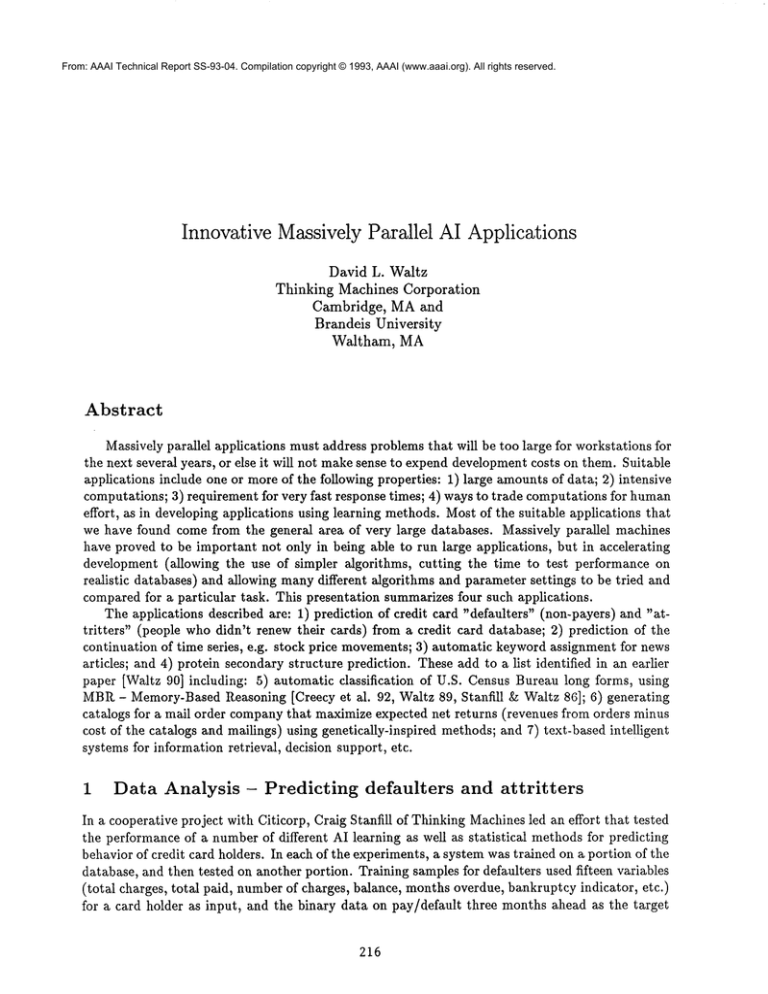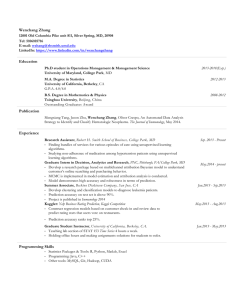
From: AAAI Technical Report SS-93-04. Compilation copyright © 1993, AAAI (www.aaai.org). All rights reserved.
Innovative Massively Parallel AI Applications
David L. Waltz
Thinking Machines Corporation
Cambridge, MA and
Brandeis University
Waltham,
MA
Abstract
Massively parallel applications must address problems that will be too large for workstations for
the next several years, or else it will not makesense to expend developmentcosts on them. Suitable
applications include one or more of the following properties: 1) large amounts of data; 2) intensive
computations; 3) requirement for very fast response times; 4) ways to trade computations for human
effort, as in developing applications using learning methods. Most of the suitable applications that
we have found come from the general area of very large databases. Massively parallel machines
have proved to be important not only in being able to run large applications, but in accelerating
development (allowing the use of simpler algorithms, cutting the time to test performance on
realistic databases) and allowing many different algorithms and parameter settings to be tried and
compared for a particular task. This presentation summarizes four such applications.
The applications described are: 1) prediction of credit card "defaulters" (non-payers) and "attritters" (people whodidn’t renew their cards) from a credit card database; 2) prediction of
continuation of time series, e.g. stock price movements;3) automatic keyword assignment for news
articles; and 4) protein secondary structure prediction. These add to a llst identified in an earlier
paper [Waltz 90] including: 5) automatic classification of U.S. Census Bureau long forms, using
MBI~- Memory-BasedReasoning [Creecy et al. 92, Waltz 89, Stanfill & Waltz 86]; 6) generating
catalogs for a mail order companythat maximize expected net returns (revenues from orders minus
cost of the catalogs and mailings) using geneticaily-inspired methods; and 7) text-based intelligent
systems for information retrieval, decision support, etc.
1
Data Analysis
- Predicting
defaulters
and attritters
In a cooperative project with Citicorp, Craig Stanfill of Thinking Machinesled an effort that tested
the performance of a numberof different AI learning as well as statistical methods for predicting
behavior of credit card holders. In each of the experiments, a system was trained on a portion of the
database, and then tested on another portion. Training samples for defaulters used fifteen variables
(totM charges, total paid, number of charges, balance, months overdue, bankruptcy indicator, etc.)
for a card holder as input, and the binary data on pay/default three months ahead as the target
216
output. About ten different methods were tested in all. The best methods tested, in order of
effectiveness on this problem, included CART(Classification and Regression Trees), 2-dimensional
additive regression, 100 nearest neighbor MBR,and 1-dimensional additive regression. The major
advantage of massive parallelism for these tasks is the ability to run a large numberof large-scale
experiments in a short time. Without fast response times, one might well be tempted to use a small
subset of a database, and to stop once a method provided what seemed like reasonable results.
2
Time series
prediction
In the fall of 1991, Xiru Zhang of Thinking Machines and Jim Hutchinson, a grad student at MIT
and part-time Thinking Machines employee, entered the Santa Fe Institute time series prediction
contest. Twomain time series, 100,000 points from a chaotic physical system and the other 30,000
points from a financial time series, were madeavailable on the Internet. The goals were to provide
the most accurate prediction for the next 500 points for each series. Zhang and Hutchinson used
backpropagation neural nets to solve both these problems. To decide on the size and structures of
the networks, they analyzed each by computing the autocorrelation function for each time series,
and finding the pattern of the meanvalue for each time series, averaged over fairly large windows.
The autocorrelations gave an idea of how large a windowwould be appropriate: quite wide (20-30
input units) for the chaotic time series, and narrow (seven input units) for the financial time series.
The financial time series also used ternary inputs (-1, 0, +1) since nearly all adjacent samples
stayed the same or movedup or downby a fixed quantum. 500 different nets were trained for each
of the series. Zhang and Hutchinson’s entries proved to be the winners for each of the contests.
(The physical system was the motion of a particle in a time-varying four-dimensional force field,
sampled at very short evenly spaced intervals; the financial times series was the exchange rate of
the Swiss franc vs. the dollar over several weeks.) The entire project was completed in two weeks,
again indicating the value of being able to do a number of large-scale experiments in a short time.
For more information, see [Zhang and Hutchinson 1992].
3
Automatic
Keyword Assignment
This project was done in conjunction with DowJones. The goal was to assign keywords to each
news article. A training sample was provided of 32,000 articles, each typically assigned from six to
eight keywords by humaneditors. The method used here was a variant of MBR.A vector similarity
text retrieval system (CMDRS
- Connection Machine Data Retrieval System) was used to find the
16 articles nearest to an article to be keyworded. Each of these near neighbors was assigned a
score, and had some number of keywords attached to it. The union of the keywords for all 16 near
neighbors was formed, and each keyword was given a score equal to the sum of the scores of all
the near neighbors in which it occurred. The system then saved the eight highest scored keywords,
provided each exceeded a threshold, and assigned them to the new article.
We were able to test this method against human keyworders. We mixed keywords assigned
automatically to articles with keywords assigned by humaneditors, and gave the randomized collection to expert humaneditors to evaluate. These expert editors graded each keyword as relevant,
irrelevant, or borderline. Counting borderline as irrelevant, the automatic system achieved a recall
217
of .8 and a precision of .72, which compares quite well to humanperformance of .82 recall and .88
precision [Masand et al. 1992]. More recent work has used a variant of Koza’s genetic algorithm
methods [Koza 92] to evolve an expression that is used to decide whether to acceptor reject each
keyword assignment. Using this method, [Masand 93] has shown that if it is allowed to refer 8%
of the articles to humans for keywording, this system can achieve performance better than human
editors on the remaining 92%of the articles.
The original system required two months of effort by a two person team. The genetic algorithm
enhancement has required an additional person-month.
4
Protein
secondary
structure
prediction
In his Ph.D. thesis work at Brandeis University, much of it done while a part-time employee
of Thinking Machines, Xiru Zhang implemented a system that now holds the world’s record for
accuracy in protein secondary structure prediction [Zhang et al. 92]. It is now easy to analyze
amino acid sequences; the sequences for over 20,000 proteins are now known. However, it is very
difficult to find the three-dimensional structures of proteins; fewer than 1000 are known, and a
large fraction of these are hemoglobins. The reason is that, to find three-dimensional ("tertiary")
structure, researchers must crystallize the protein, and then perform X-ray diffraction analysis.
This process typically requires 2-3 years time for two or three researchers; moreover, some proteins
apparently cannot be crystallized,
and so resist tertiary structure analysis. Computer methods
for finding tertiary structures for unknownproteins has also proved intractable to date, and most
researchers have worked on the simpler problem of finding the portions of an amino acid sequence
that correspond to helices, to sheets (two-dimensional structures that consist of parallel bonded
strand sections of the amino acid sequence), or to "coil" (anything that isn’t a helix or sheet).
Until recently the best secondary structure results had used a backpropagation neural net
[Sejnowski & Qian 89]. Zhang redid this work, but with a larger training set (about 110 nonhomologous proteins with helix-sheet-coil
labelings) drawn from the Brookhaven database [Kabsch
& Sander 85], and achieved similar results. He also tried other methods, including a statistical
method he devised, which was about as accurate as the neural net, and MBI~, which was a little
better than the other two. However, Zhang noticed that these three methods only agreed with each
other about 80%of the time. He thus devised a hybrid architecture that used all three methods
(neural nets, statistics and MBR)separately, and then combined the results of these three using
another neural net. The resulting system performed with about 3% greater accuracy than any
other system built to date, an increase that is highly significant statistically. Again, the ability to
do a number of experiments, each of a large size, led to significantly increased performance.
5
Summary
Massively parallel machines have proved useful for a numberof large database-related tasks. It has
generally been important to be able to perform many experiments, and to do so on large amounts
of data. Learning and memory-based methods have required modest amounts of time to program,
218
and have yielded excellent
performance when compared to other programs as well to to humans.
References
Creecy, 1L, B. Masand, S. Smith & D. L. Waltz. "Trading MIPS and Memory for Knowledge
Engineering." CACM
35, 8, August 1992, 48-64.
Kabsch, W. & C. Sander. "Dictionary of protein secondary structures: pattern recognition
hydrogen-bonded and geometrical features." Biopolymers 22, 1983, 2577-2637.
off
Koza, J. Genetic Programming: On the Programming of Computers by Means on Natural Selection.
Cambridge: MIT Press, 1992.
Masand, B. "Effects of query and database sizes on classification
of news stories
based reasoning." AAAISpring Symposium on CBR, Stanford, March 1993.
using memory
Masand, B., G. Linoff, and D. L. Waltz. "Classifying news stories using memory-basedreasoning."
Proc. SIGIR Conf., Copenhagen, July 1992.
Qian, N. & T. J. Sejnowski. "Predicting the secondary structure of globular proteins using neural
network models." J. Molecular Biology 202, 1988, 865-884.
Stanfill,
C. & D. L. Waltz. "Toward Memory-BasedReasoning." CACM
29, December 1986, 12131228.
Waltz, D. L. "Memory-BasedReasoning." In M. Arbib and A. Robinson (eds.) Natural and Artificial Parallel Computation, Cambridge: MITPress, 1989, 251-276.
Waltz, D. L. "Massively Parallel
AI." Proc. AAAI-90,Boston, 1117-1122.
Zhang, X. & J. Hutchinson. "Practical Issues in Nonlinear Time Series Prediction." To appear in A.
Weigendand N Gershenfeld (eds.), Predicting the Future and Understanding the Past: Proceedings
of the 1992 Santa Fe Institute Time Series Competition, Addison-Wesley, 1993.
Zhang, X., J. Mesirov, & D. L. Waltz. "A Hybrid System for Protein Secondary Structure Prediction." J. Molecular Biology 225, 1992, 1049-1063.
219




